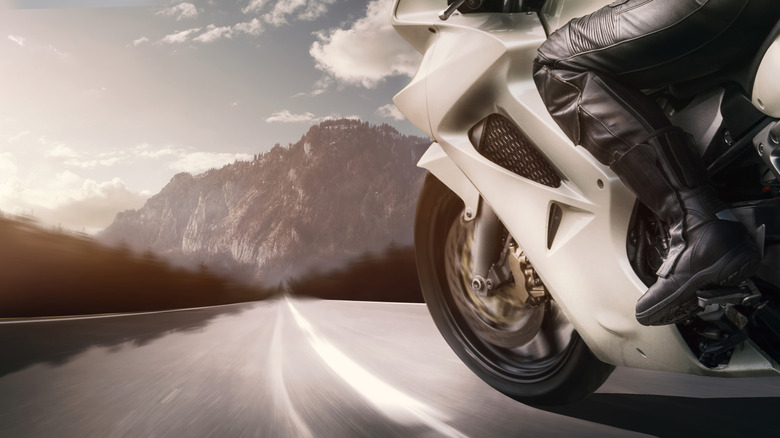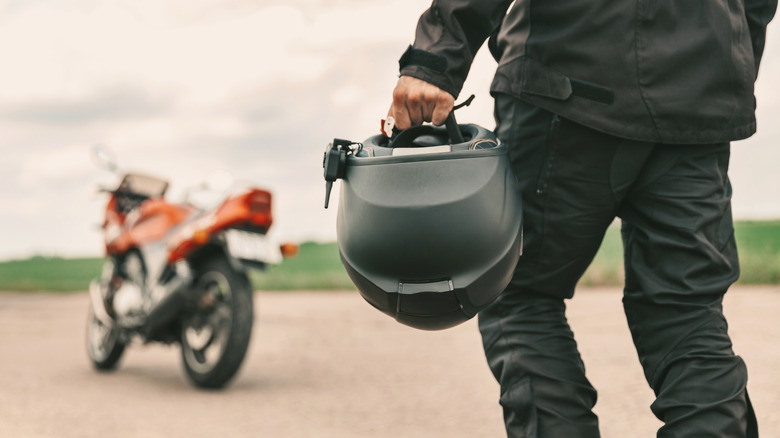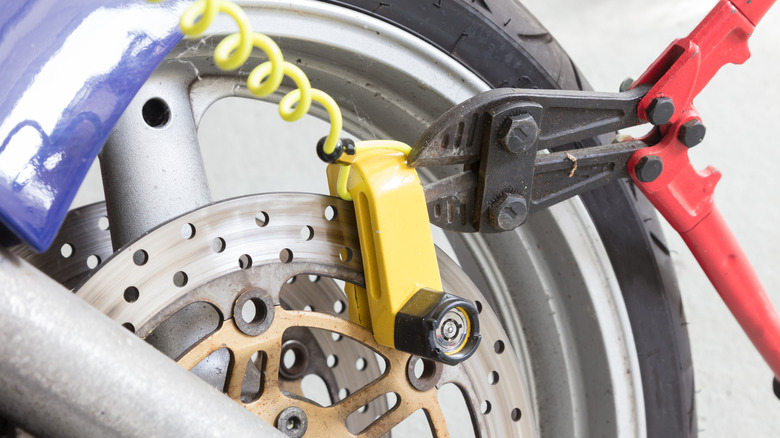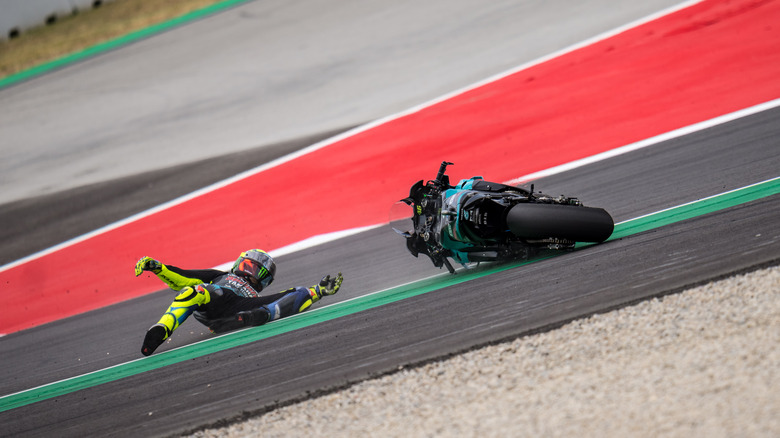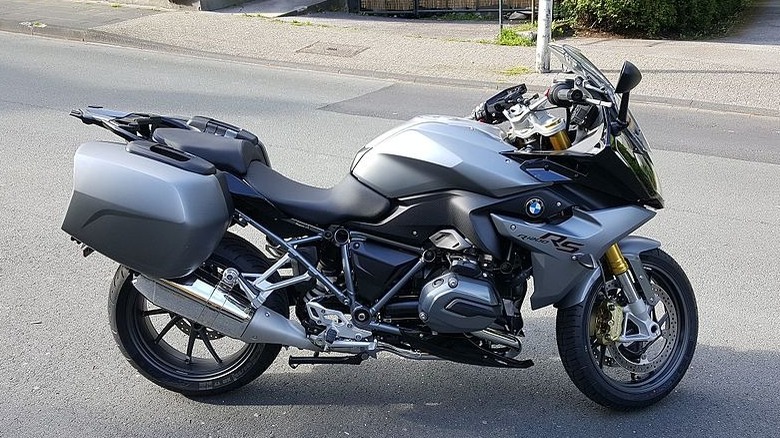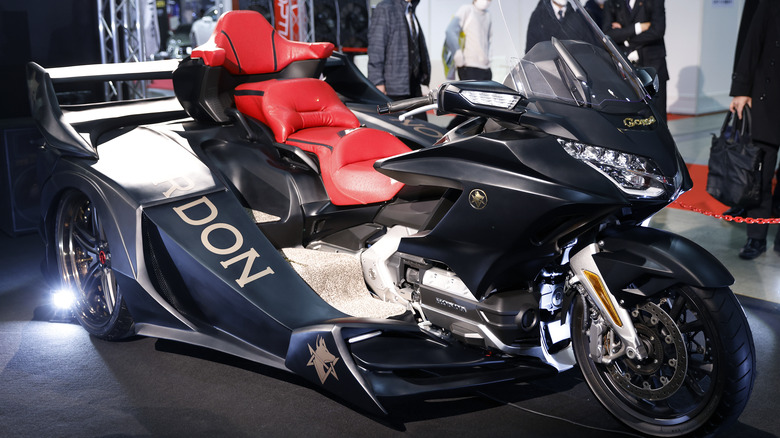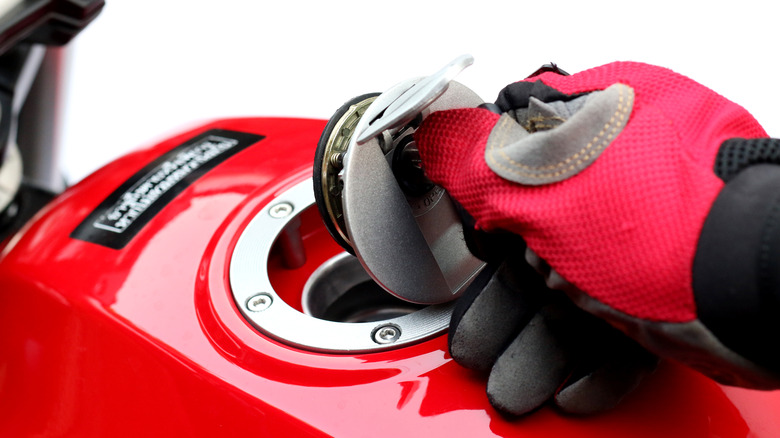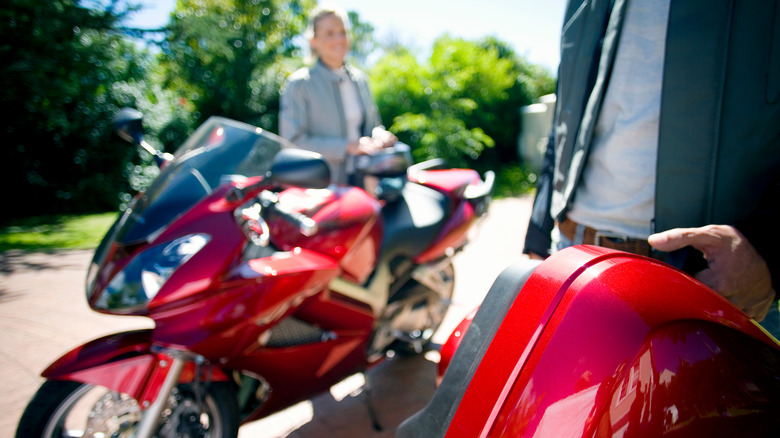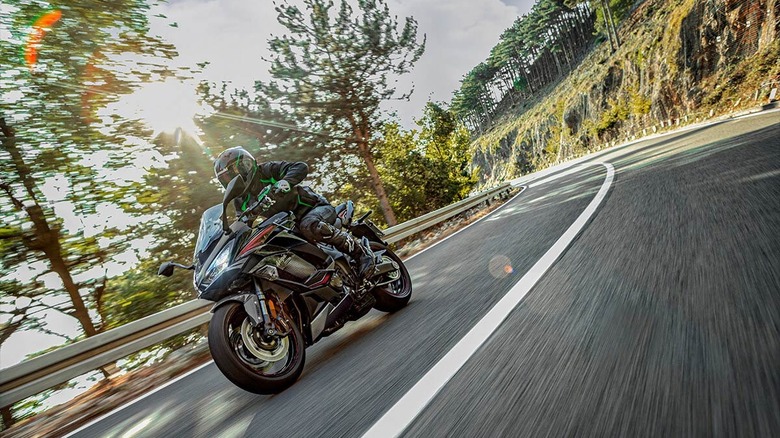5 Reasons You Shouldn't Buy A Sport Bike (And 5 Reasons To Get A Sports Touring Bike Instead)
Bikers have a certain amount of fire in their bellies, and even the most relaxed of riders will have to admit to feeling a thrill when accelerating through the gears. Many have experienced a pang of awe and perhaps jealousy when watching Moto GP riders lean at physics-defying angles as they adeptly navigate tight corners. Who in their right mind wouldn't want to take a liter-class sport bike for a spin around a dedicated circuit, just for kicks?
In this regard, sport bikes make sense, and while they are often looked down upon by other bikers — especially when helmed by overconfident, inexperienced riders — in the right hands, it takes a great level of skill and conviction to ride a sport bike to its full potential. Yet, beyond the race track, is it really worth owning and maintaining a sport bike when there is an entire smorgasbord of options available to you? Does it not make sense to factor in comfort and practicality when considering your ideal motorcycle? Perhaps most importantly, how will you transport your groceries home from the store?
For those on the fence when considering their ideal motorcycle, a sport-touring bike, with its speed and practicality, would offer the best of both worlds. Here's how the two segments compare, the drawbacks of sport bike riding and ownership, and why a sport-touring bike might be the better option.
1. Sport bikes are largely redundant
Just as most supercar owners rarely experience their vehicle's true potential, sport bikes are similar in that they cannot be ridden to their full abilities legally or safely on most public roadways. Of course, you have the benefit of acceleration, but do you really want to reach triple-digit speeds in third gear while driving in highway traffic when most drivers you share the road with are unpredictable at best and downright dangerous at worst?
Of course, if you live within spitting distance of an Autobahn, then you will be able to push your steed to its absolute limits. But even the liberal German authorities stress that you should only drive as fast as road conditions allow and to be mindful of your abilities when driving at speed.
Sure, you'll look the part in your expensive Shoei racing helmet, matching Alpinestars racing leathers, calf-length racing boots, and all the trimmings, but are these absolutely necessary when you spend most of your life riding near the speed limit? While, of course, you should always "dress for the slide and not the ride," beyond the confines of the race track, expensive racing gear is overkill for the average daily rider, and this extends to sport bikes themselves.
2. Sport bikes are costlier
Money is usually a consideration when it comes to motorcycles. After all, while they may be slightly more practical than snowmobiles and jet skis, they are often surplus to requirements and could be considered a leisure item unless it's your primary mode of transport. Even once you have paid off your two-wheeler, there will continue to be associated costs, which should be contemplated when buying a bike. For example, the average cost of insuring a sport bike is far higher than that of a touring bike, with some estimates placing it at 33% higher. This is because sport bikes are much more likely to be wrecked in an accident and are more often the target of thieves than their more conservative counterparts.
Sport bikes also cost more to run, as they have speed-optimized gear ratios and are tuned to rev higher as performance-oriented machines. This translates as quicker gas-guzzling, which is worthy of consideration. They also contain more specialist parts, such as racing tires, bespoke brakes, and lightweight components, which can be costly when it comes to regular servicing.
Therefore, if you are considering buying a sport bike, you should ask yourself whether it is worth spending the extra money on gas and maintenance, and if you use it sparingly, is it worth the extra money to insure?
3. Sport bikes require a different set of skills
Even thrill seekers ultimately want to ride safely and with confidence, and sport bikes require a good amount of skill. There is much to be said for motorcycles' effective braking, their ability to carve corners, and the feeling as you accelerate quickly out of the apex, upshifting as you do so, and this is where sport bikes really come into their own. However, if you are unfamiliar with the demands of a sport bike, its unique characteristics, and the forces at play, they should be approached with caution.
The riding position on a sport bike is an aggressive forward-leaning stance, with the legs tucked high and backward. While this lends itself to aerodynamics and speed, it is not as balanced and controlled as an upright position with the head high. This also means the center of gravity is further forward, which requires compensation when cornering, and can make maneuvering at low speeds more difficult.
Balancing throttle and clutch control can be trickier on a sport bike as they are built with a more responsive throttle and lighter clutches. While this is something that any rider will get used to with time, it can be demanding in traffic and catch you unawares if your attention slips. Handling is also markedly different on a sport bike, especially when cornering at speed. The acute lean angles may seem counterintuitive or even impossible to those unfamiliar with the nature of a sport bike.
4. Sport bikes make you a target
Unfortunately, sport bikes are both a red flag to the police and a very appealing prospect for your average recidivist, as their glossy, fully-fared exteriors seem to say "book me" or "steal me," depending on who is looking.
Even with a wheel lock and steering lock engaged, a motorcycle is a relatively easy and lucrative target for thieves. A bike is stolen every ten minutes in the US, with over half of these occurring in or around the owner's property, and fewer than half of these are recovered, as it isn't especially difficult to strip a motorcycle for parts. The vast majority of these are sport bikes (Japanese models in particular) due to their popularity, expensive components, and the fact they are lightweight, which makes them easier to lift, transport, and sell onwards.
The sport bike segment is also more likely to attract the interest of the law. It's an unfortunate fact that more bikers are pulled over on a sport bike than on any other category of motorcycle. This is because high-performance bikes can encourage aggressive riding, they stand out, and they can reach the speed limit in second gear without so much as a warning. A law enforcement officer is also more likely to run checks on your vehicle as a sport bike rider due to the aforementioned theft issues or to check them for illegal modifications and registration discrepancies.
5. Sport bikes are dangerous
While it may seem obvious, this is a point worth reiterating. There are already many risks associated with motorcycles, such as hurtling head-first into oncoming traffic as you overtake, negotiating tight corners, being exposed to the elements, and generally being less visible to other road users. With their rapid acceleration, higher top speeds, more aggressive riding position, and lighter mass, sport bikes are the most hazardous segment in an already dangerous pursuit.
There is another factor that also affects overall accident rates for sport bike riders, and that is age. Just under 60% of sport bike riders are below the age of 30, which is important when considering that they are four times as likely to experience an accident than those who ride cruisers, who make up around 25% of the under-30 crowd. So, while sport bikes are dangerous, younger riders have a higher probability of accidents than those over 30, whether due to inexperience, overconfidence, an aggressive riding style, or a combination of the three.
With this in mind, as a younger or less-experienced rider, or indeed an older rider who enjoys practicality and speed, it may be worth cutting your teeth on something more stable, leisurely, and tuned for better control at various speeds. One segment, in particular, provides a worthy compromise between performance, control, and practicality: the sport-touring bike. As such, you should consider a sport-touring bike instead.
1. Sport-touring bikes are more comfortable
Sport-tourers are characterized by common features, including a large fuel capacity, power to spare, luggage space, an effective windshield, and, importantly, comfort. This is a bike for extended trips to far-flung destinations without worry of cramps in your lower legs, tight shoulders, or aching back.
Sport-touring bikes achieve this through spacious seats, higher handlebars, lower, forwardly-positioned footpegs, and resultant upright riding position. This also makes the bike better balanced, with a commanding view of the road ahead and a feeling of confidence as you ease it around corners with less urgency and all-around better control. Sport-tourers are also far better suited for carrying pillion passengers, as their rear seat tends to be much roomier than that on a sport bike (if it even has one at all).
Better comfort translates to a better riding experience, whether you are sitting in traffic or cruising the highway at speed. It is also safer, as fatigue can cause a loss of concentration or irritability that can be dangerous, especially when riding long distances. In this instance, you will require fewer stops along the way to stretch your legs and shake out your shoulders, meaning you may even get where you are going quicker on average than if you were riding a sport bike.
[Featured image by Michael Kramer via Wikimedia Commons | Cropped and scaled | CC BY-SA 3.0]
2. Sport-touring bikes are more customizable
Many bikers wish to put a stamp on their machines, from small additions like bespoke paintwork and electronic accessories to the ostentatious and largely impractical custom choppers of the great American brands. While sport bike customization is usually limited to performance upgrades, a sport-tourer offers more potential to make it your own.
Common customization options for sports tourers include crash bars and engine covers, fog lamps, LED running lights, charger outlets, top boxes and panniers for luggage, handlebar risers, navigation bars, heated grips, taller windshields, and larger "touring" seats, to name a few. All of these are practical additions that embellish the rider experience or improve rider safety, making your time in the saddle more relaxed and enjoyable in the long run.
Of course, just as with a sport bike, you can also upgrade the performance of your sport-touring bike with aftermarket mods such as a lighter chain, sports exhaust, lithium battery, racing shocks, or performance tires. In doing so, you might find the sweet spot between comfort and speed and never look back. That said, many modern sport-tourers are already sold with performance parts that are more than fit for purpose.
3. Sport-touring bikes go further
For those of us with a long commute, the price of gas is often a significant budget consideration, and fuel economy can be a deciding factor when buying a vehicle. As a general rule, motorcycles are far more economical than gas-powered vehicles with four wheels, so bikers have an advantage straightaway, yet even within the two-wheeler category, some segments perform markedly better than others.
Sport-touring bikes enjoy a much better fuel economy than sport bikes due to their optimized gear ratios and engine mapping. These combine to provide more torque at lower revs, making them more effective for carrying heavy loads and passengers and traversing steep gradients while also making them less "thirsty" than their sporty cousins.
In addition to being more economical on fuel, sport-touring bikes have larger fuel tanks. For example, compare the BMW S 1000 XR sport-tourer's 20-liter fuel capacity with the 16.5-liter capacity of the sporty BMW S 1000 RR. This, combined with slower gas consumption, will allow you to go much further between fuel stops and can save riders a small fortune over the course of the bike's lifetime.
4. Sport-touring bikes are more practical
Sport bikes are quite a niche segment, which is part of their appeal as high-performance vehicles. Most sport bike owners would argue that their chosen vehicle is no different than a sportscar fanatic's choice of a high-performance vehicle. However, if your biking endeavors extend beyond riding fast over relatively short distances, then a sport-tourer would be more appropriate. In the same instance, should you belong to a single-car household, a more practical motorcycle could provide more usefulness as a secondary mode of transport.
As previously mentioned, a sport-tourer can comfortably seat a pillion, with their wider seats and sensibly-positioned footpegs that don't leave the knees hovering somewhere near the ear lobes. They can carry a good amount of luggage, with a mid-sized pannier and top box set averaging around 100 liters. These often come with tie-down points on the lids for lashing tents, sleeping bags, rain gear, etc., inner pockets for valuables and documents, and, perhaps most importantly, sturdy locks, so you can leave your bike unattended without worrying about theft. Their larger dashboards and windshields also accommodate navigation bars, on which you can integrate audio systems, action cameras, navigation consoles, and, of course, your trusty smartphone.
In addition, sport-tourers fare better on rough terrain, as while you wouldn't want to take one off-roading on the trails, negotiating a grassy campsite or a gravel road will be much easier due to its longer-travel suspension, higher handlebars, and balanced riding position.
5. Sport-touring bikes are still sporty
When it comes to performance, you can experience the rush of acceleration, rapid braking, and impressive top speeds on a modern sport-touring bike that will satisfy the demands of most bikers and even the most die-hard road racers among us. Indeed, to the untrained eye, it would be hard to tell the two styles apart if you were to dispense with the windshield and panniers.
Sport-touring bikes have large-capacity engines with a sporting pedigree. For example, the BMWs mentioned earlier, the S 1000 RR sport bike and S 1000 XR sport-tourer, share a common engine, albeit with different gear ratios and engine mapping to suit each segment. Sport-tourers also share full fairings and many of the mechanical attributes that define a sport bike, such as performance shocks with short rakes, performance brakes, and sports exhausts. It seems that with each passing year, the margin between the segments becomes more obscure, begging the question, is it worth opting to buy a sport bike nowadays?
Sports tourers are unquestionably more practical, economical, comfortable, and arguably more fun when you factor in the possibility of adventure that comes with long-distance touring. Granted, they don't quite have the "wow" factor of a Ducati Superleggera V4 or the eye-watering top speed of a Suzuki Hayabusa, but as far as real-world usage is concerned, sport bikes leave a little to be desired when compared to their (slightly) slower counterpart.
